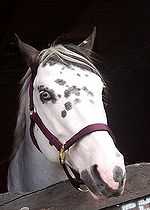Tovero
From Wikipedia, the free encyclopedia
The Tovero (also known as Tobero)[1] coloration is a mix of tobiano and overo colorations in Pinto horses and American Paint Horses. The genetics of pinto coloration are not always fully understood, and some horses have a combination of patterns that does not fit cleanly in either category.

A tovero horse with blue eyes and "Medicine hat" markings.
Some characteristics of a Tovero colored horse include:
- Dark pigmentation around the ears, sometimes called a "Medicine Hat" or a "War bonnet"
- Dark pigmentation around the ears, expanding to cover the forehead and/or eyes.
- Isolated "shield" dark markings completely surrounded by white, particularly on the face or chest.
- One or both eyes blue.
- Dark pigmentation around the mouth, which may extend up the sides of the face and form spots.
- Chest spot(s) in varying sizes. These may also extend up the neck.
- Flank spot(s) ranging in size. These are often accompanied by smaller spots that extend forward across the barrel, and up over the loin.
- Spots, varying in size, at the base of the tail.
References
- Paul D. Vrotsos RVT and Elizabeth M. Santschi DVM. University of Minnesota Genetics Group. "Stalking the Lethal White Syndrome". Paint Horse Journal. July 1998.
- "Horse coat color tests" from the UC Davis Veterinary Genetics Lab
- "Introduction to Coat Color Genetics" from Veterinary Genetics Laboratory, School of Veterinary Medicine, University of California, Davis. Web Site accessed January 12, 2008
See also
External links
- American Paint Horse Association
- Tobiano test from Veterinary Genetics Laboratory, School of Veterinary Medicine, University of California, Davis. Web Site accessed January 13, 2008
- "Horse coat color tests" from Veterinary Genetics Laboratory, School of Veterinary Medicine, University of California, Davis. Web Site accessed January 12, 2008
- "Introduction to Coat Color Genetics" from Veterinary Genetics Laboratory, School of Veterinary Medicine, University of California, Davis. Web Site accessed January 12, 2008
| |||||||||||||||||||||||||||||||||||||||||||||||
This article is issued from Wikipedia. The text is available under the Creative Commons Attribution/Share Alike; additional terms may apply for the media files.

